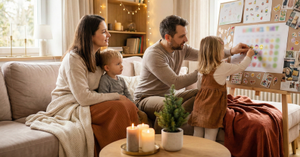Establishing a daily routine is essential for promoting learning and growth in children. A well-structured routine provides a sense of security, helps manage time effectively, and creates an environment conducive to both educational and personal development. This article will guide you through the steps of creating a daily routine that fosters learning and growth, highlighting the benefits and providing practical tips for implementation.
Benefits of a Structured Daily Routine
Enhanced Time Management
A daily routine helps children understand the value of time and how to manage it effectively. When tasks are scheduled consistently, children learn to prioritize activities and become more organized.
Increased Security and Stability
Routines provide children with a sense of security and stability. Knowing what to expect reduces anxiety and helps children feel more in control of their environment.
Improved Learning Outcomes
Consistent routines create an optimal learning environment. Scheduled study times, regular breaks, and a balance of activities help maximize focus and retention of information.
Development of Healthy Habits
Routines encourage the development of healthy habits, such as regular exercise, balanced nutrition, and adequate sleep. These habits are crucial for overall well-being and academic success.
Creating an Effective Daily Routine
1. Start with a Morning Routine
The morning sets the tone for the entire day. A positive and structured morning routine can boost mood and readiness for the day’s activities.
Examples:
- Wake-Up Time: Set a consistent wake-up time that allows for enough sleep. Aim for 9-11 hours for school-aged children.
- Healthy Breakfast: A nutritious breakfast fuels the body and mind. Include a mix of protein, whole grains, and fruits.
- Personal Hygiene: Encourage brushing teeth, washing face, and getting dressed. These tasks promote self-care and readiness for the day.
2. Allocate Time for Learning
Structured learning times are essential for academic growth. Set aside specific periods for homework, reading, and other educational activities.
Examples:
- Homework Time: Designate a quiet and distraction-free area for homework. Consistent timing helps children develop a focused study habit.
- Reading Time: Include daily reading sessions. Reading enhances vocabulary, comprehension, and critical thinking skills.
- Educational Activities: Incorporate fun and educational activities, such as puzzles, educational games, and science experiments.
3. Schedule Physical Activity
Physical activity is vital for physical health and cognitive function. It helps reduce stress, improve concentration, and boost overall mood.
Examples:
- Exercise Routine: Include at least 60 minutes of physical activity. Activities can range from sports, dancing, or simple exercises like jumping jacks and stretches.
- Outdoor Play: Encourage outdoor play to promote physical fitness and exploration. Nature walks, biking, and playground activities are excellent options.
4. Incorporate Creative and Leisure Activities
Creative and leisure activities are important for well-rounded development. They foster creativity, problem-solving, and relaxation.
Examples:
- Arts and Crafts: Set aside time for drawing, painting, or crafting. These activities enhance fine motor skills and creativity.
- Music and Dance: Incorporate music and dance sessions. Singing, playing instruments, and dancing promote emotional expression and physical coordination.
- Free Play: Allow time for free play. It encourages imagination, social skills, and independent decision-making.
5. Plan for Social Interaction
Social interactions are crucial for emotional and social development. Include time for children to interact with family and peers.
Examples:
- Family Time: Schedule regular family activities, such as game nights or shared meals. These moments strengthen family bonds and communication.
- Playdates: Arrange playdates with friends. Socializing with peers helps develop social skills, empathy, and cooperation.
6. Ensure Regular Breaks and Downtime
Breaks and downtime are essential for maintaining focus and preventing burnout. They provide opportunities for relaxation and recharging.
Examples:
- Short Breaks: Include short breaks between study sessions. A 5-10 minute break can help maintain focus and productivity.
- Relaxation Time: Allocate time for relaxation activities, such as reading a book, listening to music, or practicing mindfulness.
- Screen-Free Time: Ensure periods of screen-free time. Encourage activities that do not involve screens to reduce eye strain and promote physical activity.
7. Establish an Evening Routine
An evening routine helps wind down the day and prepares children for a restful night’s sleep. Consistent bedtime routines promote better sleep quality.
Examples:
- Dinner Time: Have a nutritious dinner together as a family. It’s an opportunity to discuss the day and foster communication.
- Bedtime Routine: Create a calming bedtime routine, including activities like taking a warm bath, brushing teeth, and reading a bedtime story.
- Consistent Bedtime: Set a consistent bedtime that allows for adequate sleep. A regular sleep schedule is crucial for physical and cognitive development.
Practical Tips for Implementing a Routine
Be Consistent but Flexible
Consistency is key to establishing a routine, but it’s also important to remain flexible. Life can be unpredictable, and it’s okay to adjust the routine as needed.
Involve Your Child
Involve your child in creating the routine. When children have a say in their schedule, they are more likely to follow it and take ownership of their time.
Use Visual Aids
Visual aids, such as charts or calendars, can help children understand and follow the routine. Use pictures and colors to make it engaging and easy to comprehend.
Set Realistic Expectations
Set realistic expectations for both you and your child. Start with small steps and gradually build up to a full routine. Celebrate progress and be patient with setbacks.
Monitor and Adjust
Regularly monitor the routine and make adjustments as needed. As your child grows, their needs and interests will change, and the routine should evolve accordingly.
Conclusion
Creating a daily routine that promotes learning and growth is a powerful tool for fostering a child’s development. By structuring the day with a balance of educational, physical, creative, and social activities, children can thrive in a supportive and nurturing environment. Consistency, involvement, and flexibility are key to implementing an effective routine. With the right approach, you can help your child develop healthy habits, enhance their learning, and build a strong foundation for future success








Be the first one to comment on this story.